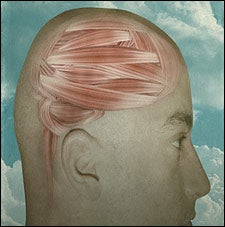UNTIL RECENTLY, conventional medical wisdom could offer only a rough sketch of the life span of your brain. It went like this: Sometime around your 21st birthday, your gray matter peaked at full size, and as the years slipped by thereafter, nothing could prevent memory loss, the steady depletion of brain cells, and the sad, slow deterioration of your once zippy intellect. It was a prospect more depressing than a Poison reunion tour. Fortunately, it was also wrong. A recent batch of studies, including a long-term project from the Howard Hughes Medical Institute in St. Louis, show that regardless of your age, you can reverse the downward spiral and continue to increase your capacity to learn. The key: training your brain as diligently as you do your body.
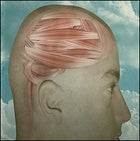
If you consistently exercise, you’re already rewarding yourself with a cerebral supercharging. “People who work out regularly have better-functioning brains,” says Dr. Richard Restak, a professor of neurology at George Washington University Medical Center. Brain experts have understood for years that general cardiovascular exercise increases the flow of blood and oxygen to your head, thereby enhancing brain function. Restak, 60, has spent the better part of two decades refining this idea. In the process of writing and researching more than a dozen books stressing the correlation between a fit brain and a well-tuned body—including the best-selling The Secret Life of the Brain—he’s used the latest scientific findings to design efficient brain-boosting regimens. For outdoor athletes, that means balance drills and hand-eye challenges that improve the synergy between your brain and muscles.
Restak is also an expert on ramping up brain function through mental training. After years spent studying the cognitive abilities of subjects ranging from fighter pilots to musicians, he developed the idea that the brain is a dynamic structure that can be improved when challenged. It’s no crackpot theory. Recent studies from several of the world’s top brain research centers have revealed that adding a steady dose of intellectual bench-pressing—brain teasers, anagrams, riddles, or memory games—can enable you to continually upgrade your ability to learn and access improved mental performance for outdoor sports. “Where sheer mental agility is concerned,” says Restak, “our brain capacity can keep expanding as long as we live.” As the world’s premier personal coach for your gray matter, he can show you the way.
Here’s Restak’s two-part approach to brain development—physical and mental—which you can effortlessly incorporate into your existing workout plan. But if you’re still balking at the hard work, here’s a quick review of the alternative: brain shrinkage. Just as it does to your muscles, neglect will take an ugly toll on your intellect. The choice, my fine mental midgets, is yours.
Sweat Smarts
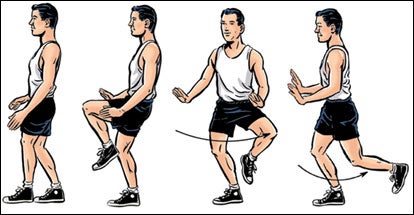
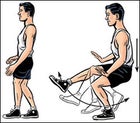
TIGHTROPE (1 set)
1. Imagine standing on an invisible rope, left foot in front of the right and hands to either side. Shift all your weight back to the right leg, keeping it slightly bent, extend it to the left side, then extend it behind you and place it behind the right leg. 2. Repeat with the right leg and continue taking slow steps backward along a straight line for ten steps. ADVANCED: As you proceed backward, keep your yese closed.
1. SWEAT SMARTS
CARDIOVASCULAR WORKOUTS—running, swimming, biking, etc.—help more blood and oxygen reach every fold, synapse, and cell of your brain, thus improving the organ’s ability to run smoothly. But keeping your brain well oiled isn’t the same as increasing its capacity to learn and grow, and it wasn’t until recently that neurologists grasped how exercise can affect the very building blocks of the spaghetti inside your head.
In 1997, researchers at the Pasteur Institute in Paris discovered that exercising muscles stimulated the growth of brain axons—branches on each nerve cell that transmit information to other neurons. And more axons means more smarts. Subsequent studies found that exercise also triggers neurogenesis (new cell growth in the brain), which improves learning. Just last June, researchers at the University of California-Irvine’s Institute for Brain Aging published a report showing how exercise in rats increased levels of neurotrophins, proteins that stimulate the growth of new nerve cells in the part of the brain that deals with learning and memory.
CROUCHING TIGER (1 set)
1. Stand with your weight on your left leg,squatting slightly, with your right leg behind you and your toes just touching the floor. 2. Swing your right leg out in front of you. With your knee bent, raise your thigh parallel to the ground. 3. Hold that position for the 10 seconds, then straighten your leg and crouch on the left as low as you can and hold that position for 10 seconds. 4. Stand on both feet. 5. Repeat the excercise with the other leg, ADVANCED: Try holding the poses for longer durations.
Outdoor athletes aren’t rats, of course, but Restak stresses that certain types of regimens can target areas of your gray matter that improve performance. “Anything you do that requires coordination tests the cerebellum,” the area of the brain that controls balance, dexterity, and planning. “And unlike muscles, it doesn’t wear out. It improves the more we challenge it.”
To give it that challenge, you’ll want to learn some basic tai chi, the ancient slow-motion martial arts practice. Restak recommends tai chi because it requires balance and leg strength, which arouse the portion of the cerebellum that controls balance and coordination. By keeping this area stimulated, you can develop stronger mental agility and promote synergy between your brain and muscles. With practice over time, this can help you navigate a tough set of rapids or negotiate swift backcountry turns. Tai chi classes are widely available, but to get yourself started, try adding the two simple exercises shown at left and above before or after your endurance and strength workouts.
Brain Work
2. BRAIN WORK
EXERCISE IS GREAT, but holding your own against Stephen Hawking takes more than working up a sweat. To increase your brain’s capacity, you need a mental regimen that will consistently take on the three cognitive regions of the brain: the frontal lobe (in charge of speech and planning), the hippocampus (memory), and the parietal lobes (processing sensory information). It’s easier than it sounds.
Memory tests, word puzzles, and other brain teasers can stimulate all three of these areas of the brain, actions that elicit two neurological responses. First, they trigger the release of neurotrophins, which promote arborization—the growth of new microfilaments, or dendrites—expanding the network that connects the regions of the brain and enhancing cooperation between the left and right sides. Or, as Restak translates it: “You build a bigger brain.” The process is somewhat akin to the way your body builds new muscle fiber after a tough weight-lifting session.
Second, such stimulation has been shown to boost plasticity, the brain’s capacity to learn, remember, and reorganize itself. A long-term study released in February of this year by the Howard Hughes Medical Institute showed that brain teasers and memory training helped rejuvenate neglected areas of the brain. By undertaking a daily set of these mental gymnastics, subjects both young and old experienced improvements in cognitive function and showed signs of reversing the typical decline in memory associated with growing old.
To take advantage of the brain’s large capacity for growth (arborization) and learning (plasticity), you need to develop your own set of mental exercises to keep your mind fertilized. The trick to doing that, says Restak, is adding a mental component to your workout. “Physical and mental skills are not opposed to each other,” he says. “They should form a continuum.” In other words, instead of simply zoning out or stewing over your stooge of a boss, try adding one or more Restak-endorsed brain teasers (see “Mind Games,” right) to your favorite ride or run. Just make sure to keep your eyes on the road.
The Zone Offense
��
| The Zone Offense | ||||||||
| Zone 1 (Z-1): Recovery 60 percent or less of your MHR |
Zone 2 (Z-2): Aerobic 60-75 percent of your MHR |
Zone 3 (Z-3): Lactate Threshold 75-90 percent or less of your MHR |
Zone 4 (Z-4): Anaerobic 90-100 percent of you MHR |
|||||
| MON. | TUES. | WED. | THURS. | FRI. | |
| (17 WEEK |
ENDURANCE Plyometric and agility series. Run/stair machine: 60 minutes in Z-2. or Cycle/swim: 90 minutes in Z-2. End with yoga. |
STRENGTH Balance exercises: Two sets of 10 to 12 reps. Power routine. Finish with core regimen. |
ENDURANCE Run/stair machine: 25 minutes in Z-1 or Cycle/swim: 40 minutes in Z-1. (Add 30-second sprints.) End with yoga. |
STRENGTH Balance exercises: Two sets of 10 to 12 reps. Power routine. Finish with core regimen. |
ENDURANCE Plyometric and agility series. Interval training: 60-minute run or cycle. After 10 minutes in Z-2, add five 5-minute Z-3 intervals with 3 minutes of Z-2 recovery after each. Finish with yoga. |
| (18 WEEK |
ENDURANCE Plyometric and agility series. Z-2. Run/stair machine: 70 minutes in Z-2 or Cycle/swim: 105 minutes in Z-2. End with yoga. |
STRENGTH Balance exercises: Two sets of 10 to 12 reps. Power routine. Finish with core regimen. |
ENDURANCE Run/stair machine: 30 minutes in Z-1. or Cycle/swim: 45 minutes in Z-1. (Add 30-second sprints.) End with yoga. |
STRENGTH Balance exercises: Two sets of 10 to 12 reps. Power routine. Finish with core regimen. |
ENDURANCE Plyometric and agility series. Interval training: 65-minute run or cycle. After 10 minutes in Z-2, add six 5-minute Z-3 intervals with 3 minutes of Z-2 recovery after each. Finish with yoga. |
| (19 WEEK |
ENDURANCE Plyometric and agility series. Run/stair machine: 80 minutes in Z-2. or Cycle/swim: 2 hours in Z-2. End with yoga. |
STRENGTH Balance exercises: Two sets of 10 to 12 reps. Power routine. Finish with core regimen. |
ENDURANCE Run/stair machine: 30 minutes in Z-1. or Cycle/swim: 45 minutes in Z-1. (Add 30-second sprints.) End with yoga. |
STRENGTH Balance exercises: Two sets of 10 to 12 reps. Power routine. Finish with core regimen. |
ENDURANCE Plyometric and agility series. Interval training: 60-minute run or cycle. After 10 minutes in Z-2, add six 5-minute Z-3 intervals with 3 minutes of Z-2 recovery after each. Finish with yoga. |
| (20 WEEK |
ENDURANCE Plyometric and agility series. Run/stair machine: 40 minutes in Z-2. or Cycle/swim: 60 minutes in Z-2. End with yoga. |
STRENGTH Balance exercises: Two sets of 10 to 12 reps. Power routine. Finish with core regimen. |
ENDURANCE Run/stair machine: 25 minutes in Z-1. or Cycle/swim: 40 minutes in Z-1. (No sprints this week.) End with yoga. |
STRENGTH Balance exercises: Two sets of 10 to 12 reps. Power routine. Finish with core regimen. |
ENDURANCE Plyometric and agility series. Interval training: 35-minute run or cycle. After 10 minutes in Z-2, add two 3-minute Z-3 intervals with 3 minutes of Z-2 recovery after each. Finish with yoga. |
Downhill Suspects (Cont.)
Fresh Loot

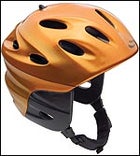
WITH FANTASTIC OPTICS, great value, and snug fit, up till now the only thing ��������É goggles lacked was panache. With the new ZYPHER, though, style finally catches up with performance. The Zypher sandwiches a Gore-Tex gasket between two lenses to minimize moisture buildup and provide a double dose of UVA and UVB protection. ($40; 800-222-6553, )
THERE SHOULD BE A SHED’S WORTH OF board tools on the market, but BAKODA’S MCIVER DRIVER gets our vote for being gloved-finger friendly: A button pops open the screwdriver like a switchblade. Plus, it’s magnetized to keep your bits from vanishing into the pow. A tape measure takes the guesswork out of swapping boards between sessions, and the palm-size design minimizes the chance of a belly-flop-induced puncture wound. ($30; 206-762-2955, )
IN SEARCH OF A FREEZE-PROOF agua system for those minus-30-windchill days, NIKE ACG worked with professional ski patrollers to develop the CONVERTIBLE HYDRATION PANTS. Hydration pants? Yep, a pocket on the lower back of the suspenders accepts a 50-ounce bladder. By nestling your H2O stash closer to your torso than traditional hydration packs do, it keeps your refreshment in its preferred, thirst-friendly state: liquid. ($250; 800-344-6453, )
THINK HELMETS ARE DORKY? One good head smack on the hardpack will change your tune. Take a less painful path to enlightenment and don GIRO’S FUSE: It’s lighter, tighter, and cooler than any other lid around. A switch lets you close or open six vents on the fly, and you can custom-tune the airflow by plugging any or all of a half-dozen other ports during the sub-zero days of January. ($150; 800-456-2355, )


